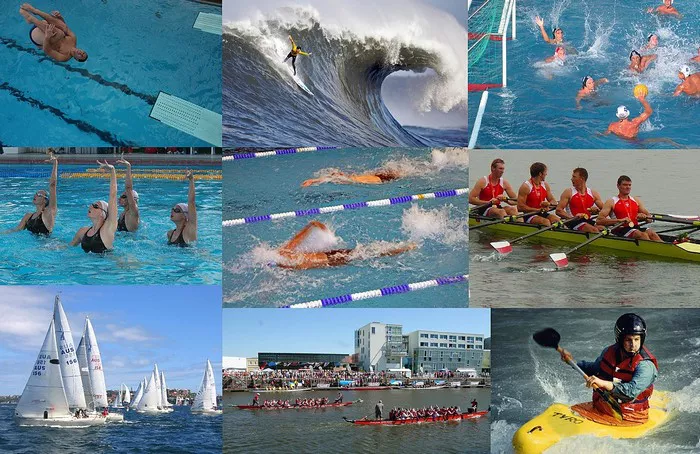Water sports encompass a diverse array of activities that bring individuals closer to the elements, offering both physical challenges and serene enjoyment. From the adrenaline rush of surfing to the tranquility of paddleboarding, water sports cater to a wide range of interests and skill levels. In this article, we delve into the various types of water sports, exploring their similarities, differences, and the unique experiences they offer.
Aquatic Adventure: Active and Passive Water Sports
Water sports can be broadly categorized into two main types: active and passive. Active water sports involve physical exertion and skill, requiring participants to actively engage with the water environment. Passive water sports, on the other hand, are more relaxed and leisurely, often involving minimal physical effort. Let’s explore each category in detail.
Active Water Sports: Riding the Waves of Excitement
Active water sports are characterized by their high-energy nature and the need for physical prowess. Participants actively engage with the water, harnessing its power to propel themselves through various activities. Some of the most popular active water sports include:
1. Surfing:
Surfing is perhaps one of the most iconic water sports, requiring surfers to ride waves on specially designed boards. It demands balance, agility, and a keen understanding of ocean dynamics. Surfers seek out the perfect wave, riding its crest with skill and finesse.
2. Kiteboarding:
Combining elements of surfing, wakeboarding, and paragliding, kiteboarding is an exhilarating water sport that involves riding a small board while being propelled by a kite. Participants harness the wind’s power to perform jumps, tricks, and high-speed maneuvers across the water’s surface.
3. Wakeboarding:
Wakeboarding involves riding a small, narrow board while being towed behind a boat. Participants use the boat’s wake to perform aerial tricks and maneuvers, showcasing their agility and balance. It’s a thrilling sport that requires strength, coordination, and a willingness to take risks.
4. Waterskiing:
Similar to wakeboarding, waterskiing involves being towed behind a boat on a pair of skis. Participants glide across the water’s surface, using their balance and strength to navigate turns and jumps. Waterskiing offers a more traditional water sport experience, focusing on speed and precision.
Passive Water Sports: Embracing Serenity and Relaxation
In contrast to active water sports, passive water sports offer a more leisurely and relaxed experience, allowing participants to immerse themselves in the tranquility of the water environment. These activities are ideal for those seeking a slower pace and a deeper connection with nature. Some popular passive water sports include:
1. Paddleboarding:
Paddleboarding involves standing or kneeling on a large board and propelling oneself through the water using a single paddle. It’s a serene and meditative activity that allows participants to explore calm waters, lakes, and rivers at their own pace.
2. Kayaking:
Kayaking offers a similar experience to paddleboarding but with the added comfort of sitting inside a small, enclosed vessel. Participants use a double-bladed paddle to navigate through waterways, exploring scenic landscapes and wildlife habitats along the way.
3. Snorkeling:
Snorkeling allows participants to explore the underwater world without the need for specialized training or equipment. Using a mask, snorkel, and fins, individuals can observe marine life up close, immersing themselves in vibrant coral reefs and exotic underwater ecosystems.
4. Fishing:
Fishing is a timeless water sport that combines relaxation with the thrill of the catch. Whether casting a line from shore or aboard a boat, anglers can enjoy the peaceful serenity of the water while waiting for the elusive bite of a fish.
Similarities and Differences: Finding Common Ground
While active and passive water sports offer distinct experiences, they share several similarities and differences that contribute to their appeal:
Similarities:
1. Connection with nature: Both active and passive water sports allow participants to connect with the natural world, whether by riding waves or exploring tranquil waterways.
2. Physical activity: While passive water sports may involve less intense physical exertion, they still offer opportunities for exercise and movement, contributing to overall health and well-being.
3. Sense of adventure: Whether surfing a wave or paddling through a serene bay, water sports offer a sense of adventure and exploration that captivates participants of all ages.
Differences:
1. Intensity: Active water sports tend to be more adrenaline-fueled and physically demanding, requiring participants to possess a higher level of skill and athleticism.
2. Equipment: Active water sports often require specialized equipment such as surfboards, kiteboards, or wakeboards, while passive water sports can typically be enjoyed with minimal gear such as a paddle or snorkel.
3. Skill level: While both types of water sports require some degree of skill and technique, active water sports may have steeper learning curves and require more practice to master.
Conclusion
Water sports offer a gateway to adventure, relaxation, and connection with the natural world. Whether riding the waves of excitement in active sports like surfing and kiteboarding or embracing the serenity of passive activities like paddleboarding and snorkeling, there’s a water sport for every enthusiast. By understanding the similarities and differences between these diverse activities, participants can choose the experience that best suits their interests and abilities, ensuring a memorable and fulfilling journey on the water.

